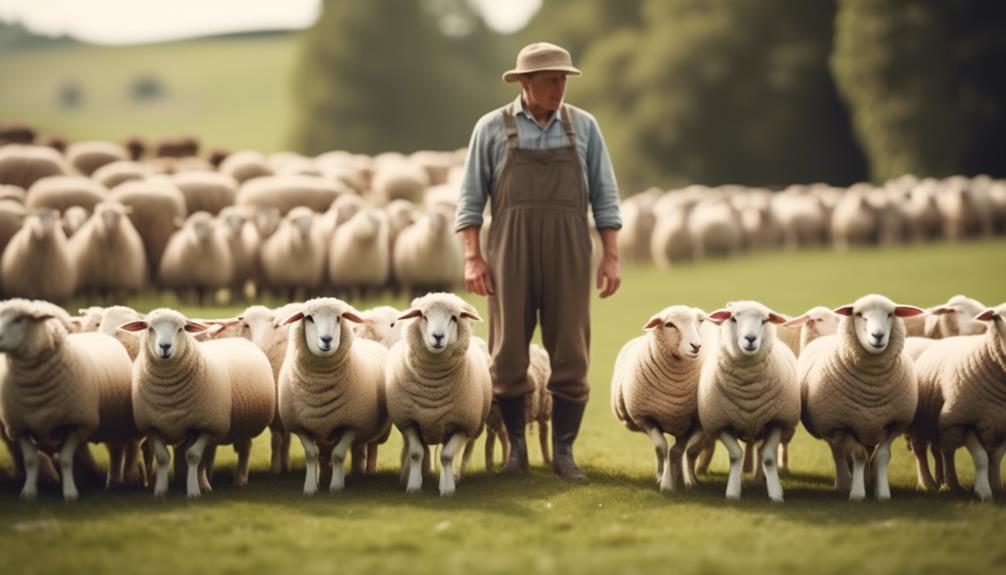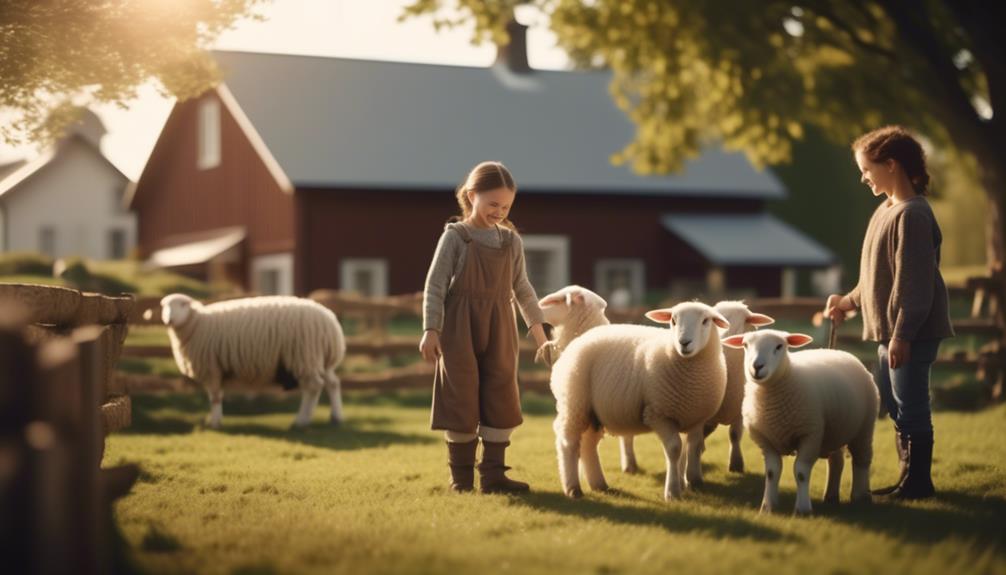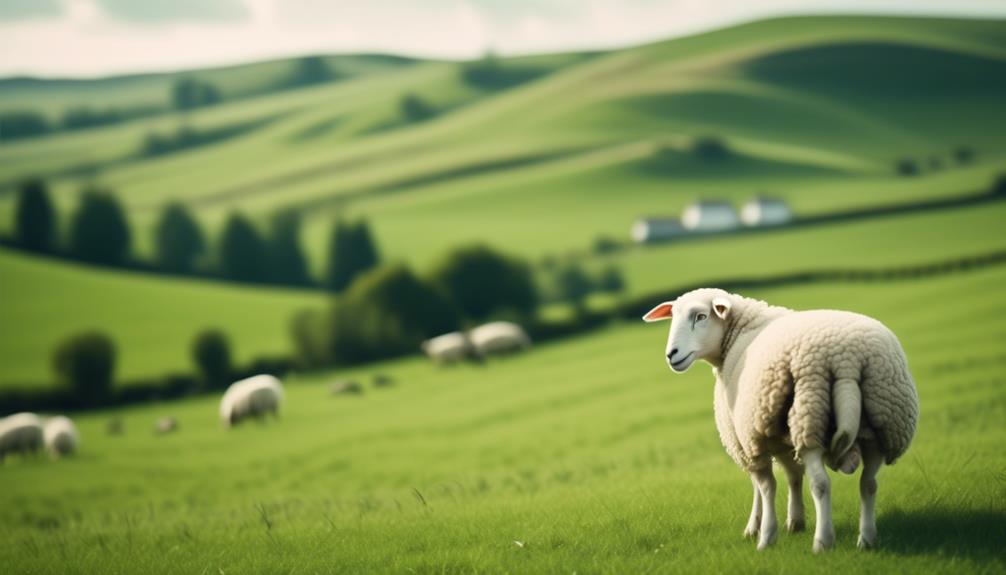Sheep have long been a symbol of pastoral tranquility, their gentle bleating and fluffy coats evoking images of idyllic countryside landscapes. However, behind their seemingly serene presence lies a realm of financial considerations that any aspiring shepherd must face. From the initial purchase price to the ongoing costs of maintenance, nutrition, and veterinary care, owning a sheep entails more than just fluffy companionship. In this discussion, we will explore the various factors that contribute to the overall cost of owning a sheep, shedding light on the financial commitments and unexpected expenses that accompany these woolly creatures. So, if you've ever wondered how much a sheep truly costs, prepare to embark on a journey through the intricate world of ovine economics.
Key Takeaways
- The purchase price and resale value of a sheep are influenced by factors such as breed, age, gender, condition, and market demand.
- Feeding and veterinary care are major ongoing expenses in sheep ownership, including the cost of quality feed, regular check-ups, vaccinations, and emergency care.
- The cost of feeding sheep is largely dependent on the price and availability of hay, as well as any necessary nutritional supplements.
- Adequate shelter and fencing are essential for the well-being and safety of sheep, and factors such as weather, predators, and budget should be considered when choosing materials.
Initial Purchase Price

The initial purchase price of a sheep is a crucial factor to consider when starting a sheep farming business, as it directly impacts the overall profitability and return on investment. When deciding on the initial purchase considerations, it is important to evaluate the potential resale value of the sheep as well.
The cost of purchasing a sheep can vary significantly depending on several factors. Firstly, the breed of the sheep plays a major role in determining its purchase price. Different breeds have varying characteristics such as wool quality, meat production, and adaptability to different climates. Breeds that are known for their superior traits often command a higher purchase price.
Another factor to consider is the age and gender of the sheep. Younger sheep, known as lambs, are generally more expensive than older ones. Ewes, female sheep, are usually priced higher than rams, male sheep, due to their reproductive potential. Additionally, the condition and health of the sheep should be thoroughly assessed before making a purchase, as any underlying health issues can affect its productivity and value.
It is also important to consider the potential resale value of the sheep. While the primary goal of sheep farming is often meat or wool production, there may come a time when certain sheep need to be sold. Understanding the market demand for specific breeds and traits will help determine the potential resale value of the sheep.
Maintenance and Upkeep Costs
When considering the maintenance and upkeep costs of owning a sheep, two major expenses to consider are feeding and veterinary care. Feeding costs can vary depending on the type of feed and the nutritional needs of the sheep, but it is important to budget for a consistent supply of quality feed to maintain their health. Additionally, regular veterinary care, including vaccinations, deworming, and routine check-ups, is essential to prevent and treat any potential health issues that may arise. Planning for these expenses is crucial to ensure the well-being of your sheep and to maintain a sustainable investment.
Expenses for Feeding
Feeding expenses constitute a significant portion of the overall maintenance and upkeep costs associated with keeping sheep. One of the major costs involved in feeding sheep is the cost of hay. Providing sufficient and quality hay is essential for the health and well-being of the animals. The cost of hay can vary depending on factors such as location, quality, and availability. To give you an idea of the expenses involved, here is a breakdown of the average cost of hay per month for a small flock of sheep:
| Item | Quantity | Unit Cost ($) | Total Cost ($) |
|---|---|---|---|
| Hay | 25 bales | 10 | 250 |
| Supplements | – | 50 | 50 |
| Total | – | – | 300 |
These figures are approximate and can vary based on your specific circumstances. It's important to budget accordingly and consider the cost of hay as part of the ongoing expenses of raising sheep.
Costs of Veterinary Care
The cost of veterinary care is a significant aspect of the maintenance and upkeep expenses associated with keeping sheep. To give you a better understanding of the financial implications, here are four key items to consider:
- Costs of Vaccinations: Sheep require regular vaccinations to protect them against diseases such as clostridial diseases, pneumonia, and foot rot. These vaccinations are crucial for maintaining the health and well-being of the flock.
- Costs of Spaying/Neutering: Depending on your specific goals for your flock, you may choose to spay or neuter your sheep. This procedure helps control reproduction and can prevent unwanted pregnancies. It is important to consult with a veterinarian to determine the best approach for your flock.
- Routine Health Check-ups: Regular check-ups are essential to monitor the overall health of your sheep. These check-ups can help identify any potential health issues early on, allowing for prompt treatment and prevention of further complications.
- Emergency Veterinary Care: Accidents or sudden illnesses can occur, requiring immediate veterinary attention. Emergency veterinary care can be costly, so it is important to have a contingency plan in place to handle unexpected situations.
Shelter and Fencing Expenses

To ensure the safety and well-being of sheep, it is essential to invest in proper shelter and fencing infrastructure. Adequate shelter is crucial for protecting sheep from extreme weather conditions, predators, and diseases. When considering shelter requirements for sheep, it is important to take into account factors such as the size of the flock, local climate conditions, and available resources.
Sheep require shelter that provides protection from wind, rain, and excessive heat or cold. A well-designed shelter should have good ventilation to prevent respiratory issues, sufficient space to accommodate the flock comfortably, and proper drainage to avoid the accumulation of moisture. Additionally, the shelter should be constructed with durable materials that can withstand harsh weather conditions and be easily cleaned and maintained.
When it comes to fencing options, there are several factors to consider. Fencing serves as a boundary to keep the sheep within their designated area and protect them from predators. It is essential to choose fencing materials that are sturdy and can withstand the pressure and weight of the sheep. Common options include woven wire, electric fencing, and barbed wire. The choice of fencing will depend on factors such as budget, the terrain of the land, and the level of predator threat in the area.
Investing in proper shelter and fencing infrastructure is a necessary expense when raising sheep. It not only ensures the safety and well-being of the animals but also helps to prevent potential losses due to injuries or predation. Proper planning and consideration of shelter requirements and fencing options will help create a safe and secure environment for the flock, allowing them to thrive and reach their full potential.
Feed and Nutrition Expenses
When considering the cost of owning a sheep, feed and nutrition expenses are a crucial aspect to consider. Feeding requirements and costs vary depending on factors such as the breed, age, and purpose of the sheep. Nutritional supplements may be necessary to meet specific dietary needs, and the management of grazing and pasture also impact the overall feed and nutrition expenses. Proper planning and understanding of these factors are essential in estimating and managing the feed and nutrition expenses for sheep.
Feeding Requirements and Costs
Feeding requirements and costs, specifically those related to feed and nutrition expenses, play a crucial role in determining the overall financial investment required to raise a sheep. Properly meeting the dietary needs of a sheep is essential for its growth, health, and productivity. Consider the following feeding requirements and associated costs:
- Feeding Schedule: Sheep should be fed at regular intervals, typically twice a day. This ensures that they receive a balanced diet and their nutritional needs are met consistently.
- Dietary Needs: Sheep require a diet high in fiber, such as good-quality hay or pasture, to maintain their digestive health. Additionally, they need a mineral supplement to fulfill their nutritional requirements.
- Feed Costs: The cost of feed can vary depending on the region and the type of feed chosen. It is important to consider the long-term expenses associated with feeding a sheep when budgeting for its care.
- Feed Efficiency: Sheep have a relatively high feed efficiency, meaning they convert feed into body weight gain efficiently. This can help in optimizing feed costs and maximizing the return on investment.
Nutritional Supplements and Expenses
Nutritional supplements and expenses are essential considerations when calculating the overall cost of raising a sheep, as they directly impact the health, growth, and productivity of the animal. Proper nutrition is crucial for the well-being of sheep and can significantly affect their performance and profitability. When it comes to nutritional supplement options, there are various choices available, such as mineral blocks, protein supplements, and vitamin additives. These supplements help meet the specific dietary needs of sheep, ensuring they receive adequate nutrition for optimal growth and development. However, budgeting for nutritional supplements is also an important aspect of sheep farming. Farmers must carefully evaluate the cost-effectiveness of different supplement options and determine the most suitable ones based on their flock's requirements and available resources. By incorporating budgeting for nutritional supplements into their overall financial plan, farmers can ensure the health and productivity of their sheep while minimizing unnecessary expenses.
Grazing and Pasture Management
Effective management of grazing and pastures is crucial for optimizing feed and nutrition expenses in sheep farming. By implementing proper grazing techniques and pasture rotation, sheep farmers can ensure that their flock has access to high-quality forage throughout the year. Here are four key strategies to consider:
- Rotational Grazing: Dividing the pasture into smaller paddocks and rotating sheep between them allows for better forage utilization, reduces parasite load, and promotes pasture regrowth.
- Rest and Recovery: Allowing pastures to rest and recover after grazing helps maintain their productivity and prevents overgrazing.
- Supplemental Feeding: In cases where forage quality or quantity is insufficient, providing supplemental feed can help meet the nutritional needs of the sheep.
- Weed Control: Regular monitoring and control of weeds in pastures ensure that valuable forage species can thrive and provide adequate nutrition for the flock.
Veterinary Care and Medical Costs
Veterinary care and medical costs are essential aspects of sheep farming that require careful consideration and financial planning. As responsible shepherds, it is crucial to prioritize the health and well-being of our flock. This includes regular check-ups, preventive care, and timely medical interventions when necessary.
One way to mitigate the financial burden of veterinary expenses is by considering veterinary insurance. Just like health insurance for humans, veterinary insurance provides coverage for the cost of medical treatments and procedures. It can help alleviate the financial strain of unexpected illnesses or injuries that may arise in your sheep. It is advisable to research different insurance providers and policies to find one that best suits your needs and budget.
Preventive care costs should also be factored into your sheep farming budget. Regular vaccinations, deworming, and hoof trimming are necessary to maintain the overall health of your flock. These preventive measures not only reduce the risk of diseases but also contribute to improved productivity and longevity in your sheep. It is advisable to consult with a veterinarian to develop a proper preventive care plan tailored to your specific flock's needs.
In addition to preventive care, it is important to be prepared for potential medical emergencies. Accidents, infections, or complications during lambing can occur unexpectedly, and the cost of emergency veterinary care can be substantial. Setting aside funds specifically for emergency medical expenses can help ensure that you can provide timely and necessary treatment for your sheep when needed.
Unexpected Expenses and Contingency Budget

To ensure financial stability in sheep farming, it is essential to anticipate unexpected expenses and establish a contingency budget. Unexpected expenses can arise at any time and can significantly impact the profitability of a sheep farming operation. By implementing a contingency plan, farmers can mitigate the financial risks associated with unforeseen circumstances. Here are four key areas to consider when planning for unexpected expenses:
- Emergency Veterinary Care: Sheep can fall ill or get injured, requiring immediate medical attention. Veterinary costs can quickly add up, especially if extensive treatment or surgery is necessary. It is crucial to allocate funds for emergency veterinary care to ensure the health and well-being of the flock.
- Equipment and Infrastructure Repair: Farming equipment and infrastructure, such as fences, barns, and water systems, can break down or require maintenance. These unexpected repairs can be costly and disrupt daily operations. Having a contingency budget specifically designated for equipment and infrastructure repairs can help prevent financial strain.
- Feed and Supplements: Fluctuating feed prices and unexpected shortages can put a strain on a sheep farmer's budget. By having a contingency budget for feed and supplements, farmers can adapt to market changes and ensure that their flock receives proper nutrition, even during challenging times.
- Market Volatility: Sheep farming is susceptible to market fluctuations, which can impact the profitability of the business. It is essential to have a contingency budget to cover potential losses during periods of low market prices or unexpected changes in demand.
Frequently Asked Questions
How Much Does It Cost to Transport a Sheep to Its New Home?
Transportation costs for transporting a sheep to its new home can vary depending on various factors such as distance, mode of transportation, and additional services required. It is important to consider quarantine requirements, which may incur additional costs. To determine the exact cost, it is advisable to consult with professional livestock transporters or agricultural authorities who can provide accurate and up-to-date information on transportation costs and quarantine regulations in your specific location.
Are There Any Additional Costs Associated With Acquiring Necessary Permits or Licenses for Owning a Sheep?
Acquiring necessary permits or licenses for owning a sheep may involve additional costs. It is important to comply with legal requirements to ensure the welfare and safety of the animal, as well as to avoid potential fines or legal issues. These permits/licenses may vary depending on the specific location and regulations. It is advisable to consult local authorities or agricultural agencies to determine the exact costs and requirements associated with owning a sheep. Adage: "Compliance is the key to a successful and lawful ownership."
Can the Initial Purchase Price of a Sheep Vary Depending on Its Breed or Age?
The initial purchase price of a sheep can vary depending on its breed or age. Cost variation based on breed is influenced by factors such as the quality of wool and market demand for different breeds. Certain breeds known for their high-quality wool may command a higher price. Additionally, younger sheep may be priced differently compared to older ones due to factors such as health and breeding potential. Understanding these dynamics can help potential buyers make informed decisions regarding the cost of acquiring a sheep.
Are There Any Ongoing Costs for Shearing or Grooming a Sheep?
When considering the ongoing costs associated with sheep ownership, it is important to take into account the regular grooming and shearing requirements. Sheep shearing is a necessary practice to remove the wool, which can accumulate and cause discomfort for the animal if left unattended. Grooming involves tasks such as cleaning and inspecting the sheep's coat, which helps maintain their health and overall well-being. These activities may require professional assistance or specialized equipment, adding to the ongoing expenses of sheep ownership.
What Is the Average Lifespan of a Sheep and Are There Any End-Of-Life Expenses to Consider?
The average lifespan of a sheep ranges from 10 to 12 years, although it can vary depending on various factors such as breed, diet, and overall health. As sheep age, there may be additional expenses to consider, particularly in terms of veterinary care and end-of-life arrangements. These expenses can include euthanasia, burial or cremation services, and any necessary post-mortem examinations. It is important for sheep owners to plan and budget for these potential costs to ensure the wellbeing and proper management of their flock.
Conclusion
In conclusion, the cost of owning a sheep involves various factors, including the initial purchase price, maintenance and upkeep costs, shelter and fencing expenses, feed and nutrition expenses, veterinary care and medical costs, as well as unexpected expenses and the need for a contingency budget. It is crucial for potential sheep owners to consider all these aspects before making a decision. As the saying goes, "A well-prepared shepherd knows that the price of a sheep goes beyond its initial cost, requiring a diligent and calculated financial commitment."

